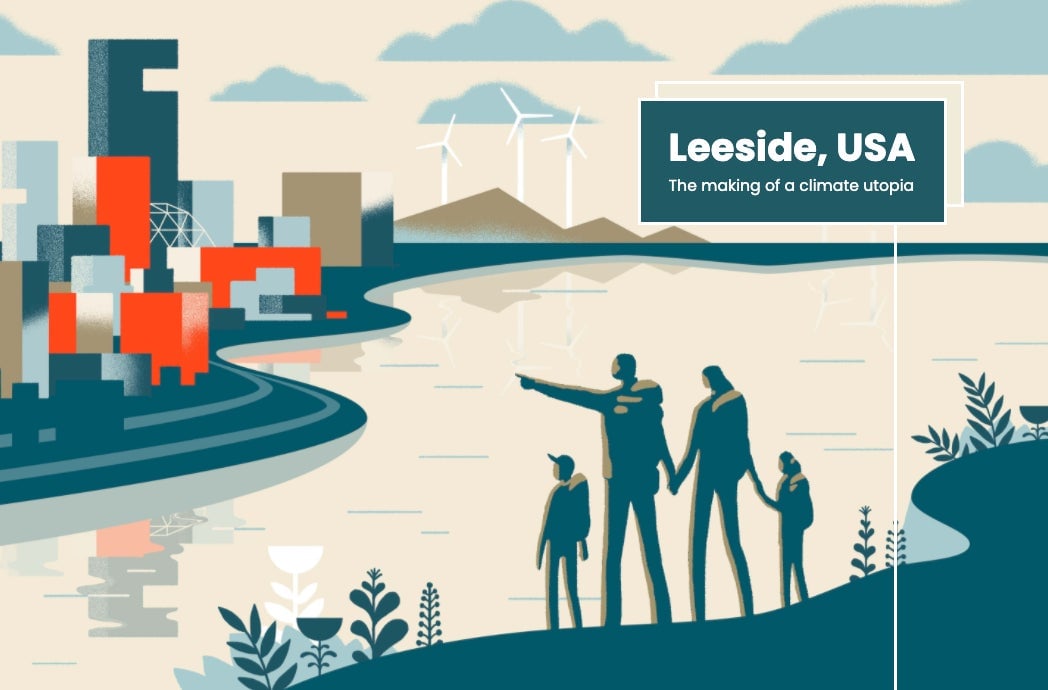The Race to Zero Emissions: Building havens for climate migrants
Scientists are increasingly confident that climate change may drive the largest mass migration in human history. The destruction to lives, property, and livelihoods wrought by storms, sea level rise, wildfires, and drought will force tens of millions of people to look for a safer place to call home.

Scientists are increasingly confident that climate change may drive the largest mass migration in human history. The destruction to lives, property, and livelihoods wrought by storms, sea level rise, wildfires, and drought will force tens of millions of people to look for a safer place to call home.
But where will that new home be, and what will migrants find there?
One answer is a climate haven: a city that is both insulated from extreme weather and well-resourced enough to support an expanding population. The hope is that, rather than fleeing from a storm or being forced out by unaffordable insurance premiums, residents of vulnerable places will feel empowered to seek a safer home if well-organized alternatives are available.
It will require years of planning and huge investments to remake these cities to accommodate a new population—one that is not just larger, but more diverse in terms of race, culture, and income. These havens will demand a willingness to see the climate catastrophe as an opportunity to create cities that are more equitable, sustainable, and productive.
So my colleagues and I set ourselves an unusual task: What if, in addition to reporting on efforts to study and create climate havens, we invented one of our own? It would be an experiment in conjectural multimedia journalism, grounded in real-life data and input from a lot of very smart people outside of Quartz.
The result is Leeside, a fictional city of the future that has remade itself as a haven for climate migrants. The city has a history of travails and triumphs, which you can explore in a museum exhibit from the year 2057 assembled by visual journalist Amanda Shendruk. And you can try your own hand at designing a climate haven by playing with a custom urban planning simulator.
Our goal with this project isn’t to prescribe a single model for climate havens. Instead, it’s to advance the conversation about climate change and cities, and hopefully spark some ideas—ones that may even manifest in the real world someday. We hope you’ll let us know what you think.

Here’s what happened over the past week that helped or harmed the world’s chances of cutting greenhouse-gas emissions to zero:
⬇️ Decreases emissions
1️⃣ City planners are becoming obsessed with urban forests, which both absorb carbon emissions and offset the effects of extreme heat.
2️⃣ When Apple says jump, its suppliers ask how high—and wind up making the largest-ever corporate deal for renewable energy. Climate commitments by US tech companies are reshaping energy markets in Asia.
3️⃣ Beer brewing giant Anheuser Busch (maker of Budweiser), has transitioned one-third of its truck fleet to biogas, captured from cow poop and other agricultural operations. The switch will cut each truck’s emissions by 70%, the company said.
0️⃣ Net-zero (for now)
1️⃣ Analysts project that if Joseph Biden wins the US presidency, by 2023 the country’s oil production will be a million barrels per day lower than if Donald Trump is reelected.
2️⃣ German steelmaker ThyssenKrupp, one of the world’s biggest manufacturers, is designing a steel plant that will run on hydrogen instead of coal. Because they require so much power and heat, steel factories are among the most challenging facilities to decarbonize.
3️⃣ Canada could be in for an unexpected snap election, and one of the most hotly-contested issues is the country’s carbon tax. Conservatives have vowed to scrap it if they win control of the government from Prime Minister Justin Trudeau.

🔼 Increases emissions
1️⃣ Demand for gasoline and other fuels may never fully recover from the pandemic. So the oil industry is looking for new outlets for its products. Trade group documents reveal one key goal: to push mountains of plastic into Africa.
2️⃣ During the pandemic, thousands of US oil and gas operations got permission from the Trump administration to stop monitoring emissions and other pollution, an AP investigation found.
3️⃣ After Turkey dispatched a drilling vessel guarded by navy warships, tensions are rising in the Mediterranean as Greece, Cyprus, and others jockey for control of newly-discovered offshore oil and gas deposits.
The market’s migrating, too
A historic economic crash. Geopolitical turmoil dialed up to the max. A pandemic threatening to rip through the world’s population again. Sound like a good time to buy stocks?
It seems a little nuts, but tens of millions of people around the planet are doing it with zeal. It’s too soon to call it an outright bubble—a confounding surge in prices before the crash—but research suggests we should be vigilant. A survey of these studies indicates that bubbles are partly caused by standard economic stuff like easy credit and government policy. But they may also spring from the stories we tell each other, as well as the hormone-induced high some people get from trading. Read more in our field guide to the next bubble.
Stats to remember
As of Aug. 30, the concentration of carbon dioxide in the atmosphere was 411.90 ppm. A year ago, the level was 409.53 ppm.
Have a great week ahead. Please send feedback and tips to [email protected] and [email protected].